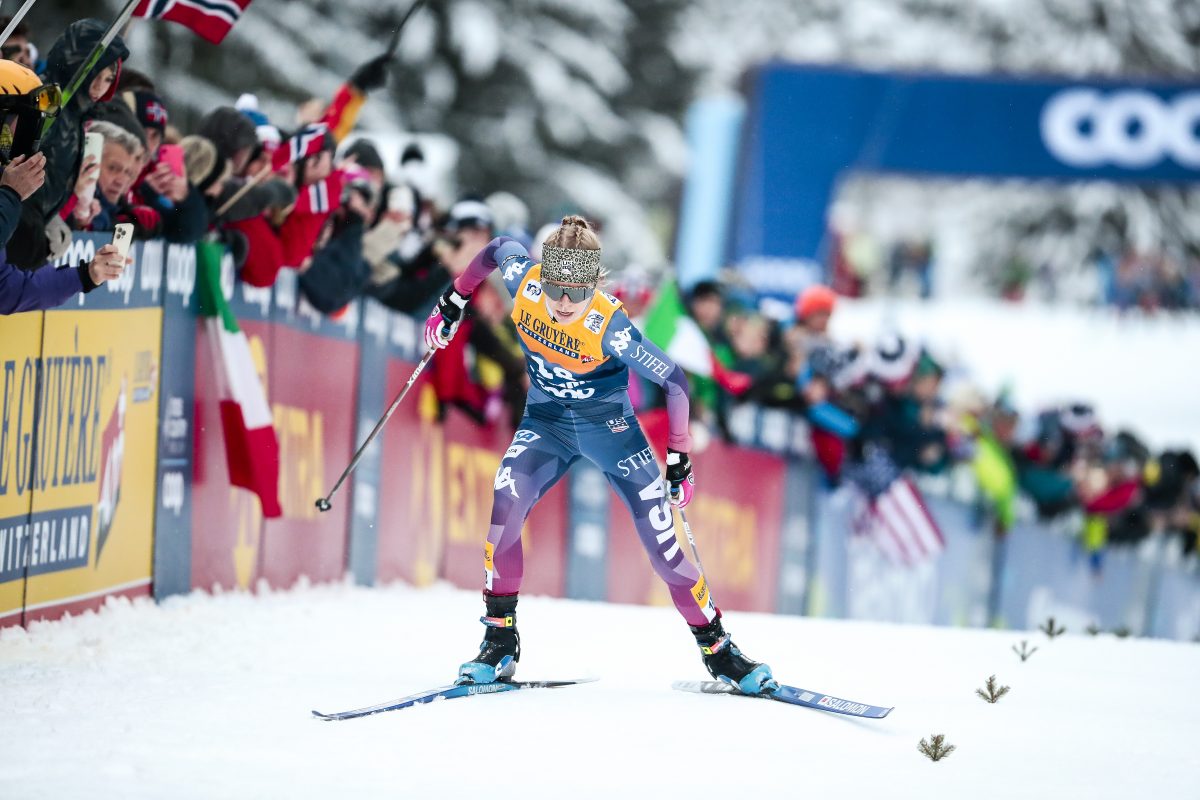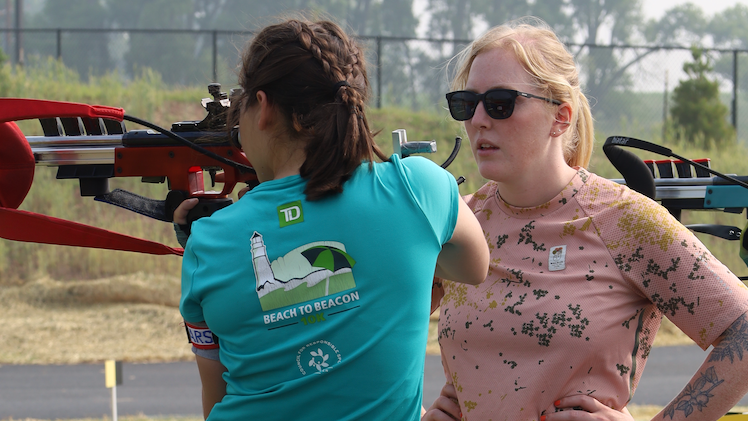
When two-time Olympian Zina Kocher was left off of Biathlon Canada’s “A” team this spring, she was surprised.
“Criteria was never set before the season started,” Kocher told FasterSkier in an interview; it wasn’t until after the season was over that athletes learned whether their results were good enough for a nomination.
Instead of simply adjusting and continuing on with the national team, Kocher turned down the “B” team nomination altogether and joined another squad, the newly formed Biathlon Alberta Regional Training Centre. While in some ways she’s stepping into uncharted territory, in others Kocher is returning to her roots: she began her career in Canmore with the Rocky Mountain Racers. That’s not where the symmetry ends, because when Kocher began her career, Richard Boruta was her coach at Rocky Mountain Racers, and he’s now the head coach at the regional center.
The veteran hopes that going back to the basics will get her skiing faster, shooting straighter, and returning to the World Cup podium for the first time since 2006.
Success, Then a Slump

Kocher started biathlon in 2000, and the very next season made the Canadian team for World Junior Championships. In three trips to the event – Khanty-Mansiysk, Russia in 2001, Antholz, Italy in 2002, and Koscielisko, Poland in 2003 – she never placed outside of the top 20, and finished 11th twice.
“When I first started biathlon, I was in Canmore, and then I made the national team as a junior and started training right away with the national team,” Kocher said.
Even as early as 2002, she began receiving World Cup starts. At first her results weren’t impressive. But after more training with the national team – which Boruta had moved up to coach – she cracked the top ten for the first time in 2003. Over the next few years, Kocher continued to show flashes of brilliance, but as a young athlete she was inconsistent: in 2005 she finished fifth in a World Cup sprint in Slovakia, but at the same event she was 74th in the individual race.
After Boruta left the national team in 2006, Kocher’s results finally took the next leap. Instead of turning in the occasional strong performance, she was frequently placing in the top twenty, and even notched a podium finish in a sprint in Sweden. That year, Kocher ended up ranked 26th on the World Cup.
She seemed to be on an upward trajectory, but things started to fall apart when Kocher missed the 2008 season due to a bout of mononucleosis. After struggling with back injuries as well, she had a disappointing Olympics in Vancouver, where she finished 65th and 72nd in the two races she started. (Maybe she had the jitters: in the World Cup races directly after the Olympics, she finished 12th and 20th.)
“My performance has gone down a little bit and I was quite disappointed with my results the last couple of years, coming back from having mono and a back injury,” Kocher said.
The 2011 season was especially grim: Kocher failed to crack the top 40 in a single race.
Rejuvenation in Canmore

Even without the team nomination issue, Kocher was beginning to feel that she needed a change. In the interview, she expressed “reservations” about the national team.
“I needed to get away from an environment where I had grown stale, to some degree,” she said. “I don’t think it’s anyone’s fault, but I think I need to go back to what made me happy and why I enjoy the sport and something that gave me a lot of confidence.”
But even though she knew that she needed a change, Kocher wasn’t exactly sure what to do. In April, Biathlon Alberta announced the new development center, and Kocher waited for new details. Even though the program was designed for U23 athletes, when the board hired Boruta as the head coach, Kocher knew she wanted to join the team.
“I asked, well, can I join this team?” she laughed. “And yes, they have some exceptions [regarding age].”
The first order of business was to shore up a training plan. After a season where her skiing felt “blah,” Kocher had ideas about how to get back to the level where she was racing before.
“Richard and I talked quite a bit about it and I felt that I was lacking in a lot of intensity, especially in the last year,” Kocher said. “And intensity with shooting, as well. I could shoot fine in easy practice but as soon as I got to a race I just couldn’t pull it together.
“So that’s what we focused on a lot, was upping the intensity level. I think that’s the biggest thing. And shooting: going back to some of the basics of shooting.”
Now that she’s back with her very first coach, Kocher believes that she’ll be able to train better and make it out of her slump.
“It is a comfort [to be training with Boruta again] because I know what to expect,” she explained. “I have full confidence in the direction with Richard and which in turns brings confidence into yourself. I know that I’ve had tremendous success with him in the past and so that adds onto the confidence building.”
For the veteran biathlete, the new Alberta program had one more thing going for it, and that was youth. While some older racers might be less than thrilled to be training with a group of developing athletes, Kocher saw it as a benefit – and the fact that the group sometimes trains with the highly successful Alberta World Cup Academy ski program was another plus.
“They have a lot of energy and are high-spirited and are super psyched about biathlon, and sometimes you forget about the reason why, or just how exciting biathlon can be when you’ve been doing it for so many years,” Kocher said. “Maybe you lose some of that excitement and you just know what hard training is. So it’s good to have that energy around.
“And you can always learn something from someone, even if they are younger,” she concluded.
Team Nominations: What Criteria?
But even though she’s happy with her move to the Alberta team, Kocher hopes that Biathlon Canada will change the way it chooses the national team. She did not enjoy her experience this spring.
“When the season came to a finale, the criteria came out,” Kocher said. “I was put on a squad that I didn’t even know existed. I didn’t even know that there were two different squad levels.”
Surprisingly, it’s not that unusual for teams to set criteria after the season has already ended, or to have discussed the criteria but not published them until it was too late for athletes to do anything about their results.

The U.S. Biathlon Association has done the same thing in the past, notably after the Vancouver Olympics, where Lanny Barnes posted the top finish by an American woman in 16 years. While most athletes would assume that a landmark performance would land them on the national team, Barnes was surprised to learn a few months later that she had not been named to the squad.
Situations like that, Kocher said, were unfair.
“It just seems so logical, I guess, to me,” she told FasterSkier. “You should have an idea of what you need to accomplish to be on the national team by the end of the season, so that you fully understand why you’re on one team and not the other, and you can take your own responsibility for not achieving that during the season.”
If throughout a season an athlete knew that they were not measuring up to criteria, then they could accept that it was their fault that they did not make a team. But when selections come as a surprise, it’s harder to take responsibility.
“I can totally understand using [coaches’ discretion to name team members], but I think that there needs to be some kind of standard that you’re supposed to make, that’s published before the season starts so that you can set your goals,” Kocher said. “You can have that in the back of your mind – even though it’s not going to take precedence over what you are going to do in a season, and it shouldn’t be your focus.”
In order to accomplish this, Kocher suggested publishing the next year’s selection criteria before the current season even began. Because this year, when she races at World Cup trials and, she hopes, on the World Cup itself, she wants to know whether her results are good enough.



